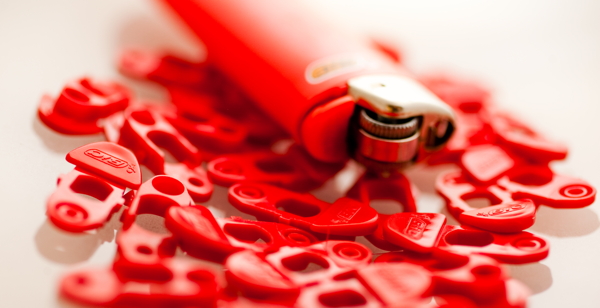stiff and strong, yet ductile and easy to machine

Acetal is one of my favorite engineering materials. Also known as polyoxymethylene (POM), polyacetal, and polyformaldehyde, acetal is a fascinating material that is often overlooked by most design engineers.
Acetal is a semi-crystalline thermoplastic with an interesting mix of properties. First of all, it has excellent mechanical properties, including high strength, high stiffness, and high toughness. Secondly, it is resistant to a wide variety of chemicals – a result of its crystalline structure. Thirdly, has a unique characteristics in the area of tribology – the science of friction, lubricity, and wear. It has a very low coefficient of friction, and outstanding wear characteristics (and all of these these characteristics can be even further enhanced with additives such as chemical lubricants and PTFE). Lastly, acetal has some unique molding properties. Since is it a crystalline thermoplastic, it has a distinct melting point. This means that flow lengths in the mold are related to temperature – NOT to pressure. Acetal also has exceptional knit line strength of acetal – in some instances the knit line strength can approach 100% of the base material. This means that you can design – and then mold – extremely complex parts with high structural integrity. (just try doing that in ABS).
There are two main types of acetal: homo-polymer, and co-polymer. The homo-polymer version was invented by DuPont in the 1950’s, with the trademark name of Delrin®. The co-polymer version came later, under the brand names Celcon®, Hostaform®, Ultraform®, Duracon®, et al. The distinctions between these two versions are subtle.
homo-polymer – has better mechanical properties, including higher mechanical strength, higher hardness, greater stiffness, and better creep resistance. It also has a slightly higher melting point than co-polymer.
co-polymer – has lower crystallinity (less shrinkage, better dimensional stability, but also diffierent chemical resistance).
other differences – homo-polymer is produced through the polymerization of formaldehyde, and upon decomposition, homo-polymer will produce formaldehyde. While stabilizers are added to homo-polymer resins to prevent decompisition during the normal molding cycle, there are sometimes “issues” that occur where molten resin will accumulate and decompose (hold-up spots in the barrel, mismatch between the nozzle and the sprue, etc). In my days at DuPont, we used to use the phrase “If it smells, it tells.” However, most molders believe their molding facility is perfect, and will never admit they have an “issue.” As a result, many molders prefer to use co-polymer.
in the real world – homo-polymer is & co-polymer are often inter-changeable. However, there are those who claim (and I am one of them), that you can ALWAYS injection mold a part faster in homo-polymer than you can in co-polymer – because the higher melting temperature means it will solidify faster than co-polymer during the injection molding process.
Acetal is also a great material for machining. As mentioned above, it is stiff, strong, and hard, and offers exceptional frictional properties. All of these properties combine to make it easy to machine, so it is great for making prototypes. It also has a very pleasing surface appearance – regardless of whether is molded, extruded, or machined.
Typical applications for acetal include molded gears, mechanisms, disposable lighters, and snap fit connectors. No doubt about it, acetal is a critical component of the material palette for any serious design engineer.
Please note: acetal – compared to other thermoplastic materials – does have a very high level of crystallinity (75-85%). This is what gives the material its strength and stiffness, while providing resistance to chemical attack. It also means that molded acetal has a high amount of mold shrinkage. So one needs to plan for this in making design and tooling decisions.
copyright © 2011 by Eric R. Larson – a.k.a plasticsguy – all rights reserved.








Great summary, Eric. Although you imply it, acetal also has some unique characteristics in regards to toughness. Perhaps you might want to show a stress-strain chart plotted against PP and others?
Mark, I thoroughly agree with your comment about acetal and its toughness. However, I don’t think a simple stress-strain chart can convey the all of the differences.
BTW, my favorite definition of toughness – “whatever property is lacking in that part that just broke.”
So if the “tongue” of the lighter is acetal, what is the body? Nylon?
Yes, the “tongue” is acetal, as is the main body, and the small plug at the bottom (which is welded in place). Acetal provides the structure as well the needed chemical resistance to the butane gas. It also has good toughness, abrasion resistance, etc.
Also, on a side note, you may notice that the “tongue” is a bright, vibrant red, where as the body is often a more muted color (red, yellow, blue, etc.). While I don’t know this for a fact, I would assume that there is a lower pigment loading in the material that is used to mold the body, as high pigment loading can have a detrimental affect on material properties.